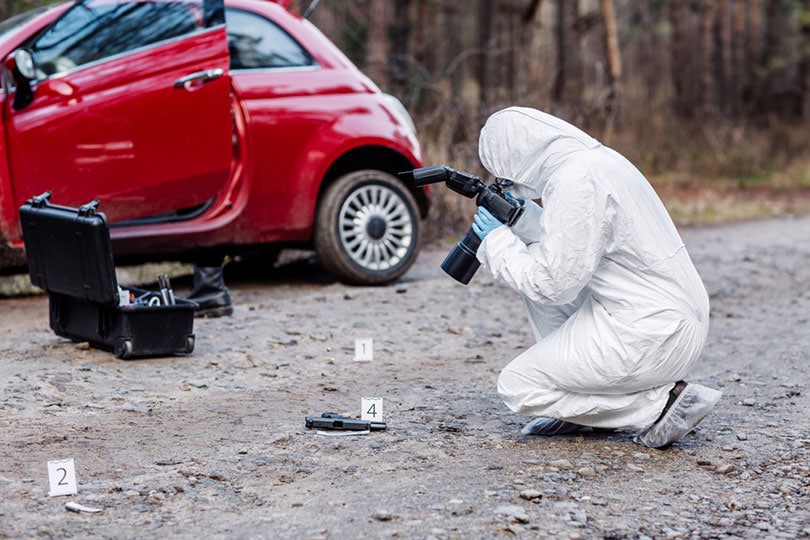How to Become a Crime Scene Photographer (Step-by-Step Guide)
Last Updated on

It’s impossible to become a crime scene photographer overnight. Even if you are a fantastic photographer, you also need additional police work to become a crime scene photographer. As a result, it’s important to know what education, certification, and steps you need to take to become a crime scene photographer.
Below, you will learn everything you need to know about becoming a crime scene photographer, including what the job entails, needed qualifications, and steps to get started. Let’s dive right in to learn more about how to become a crime scene photographer this year.

What Does a Crime Scene Photographer Do Exactly?
Before you decide to become a crime scene photographer, it’s imperative that you understand what being a crime scene photographer entails. A crime scene photographer, otherwise known as a forensic photographer, takes pictures of crime scenes to detail evidence and physical settings. Their photographs are used to help investigators detail what happened and prove a case.
With the help of crime scene photographers, investigators can determine important details of the crime. This information can also help attorneys and prosecutors during trials.
- Appearance of the victim
- Location
- Evidence
- Objects possibly involved in the crime
- Anything that may concern the crime later on
As a crime scene photographer, it will be your job to capture crime scene images. You will also need to enlarge and submit the photographs to hearings and trials. Not only that, but you will also need the critical thinking and technical skills to determine what needs to be photographed and communicated in chaotic environments.
Needless to say, becoming a crime scene photographer entails much more than simply taking pictures. You also have to know what to look for, get the right context, and communicate the photographs to other individuals involved in the case.

Expected Salary of a Crime Scene Photographer
Unfortunately, there is no specific information about how much a crime scene photographer makes. Instead, there is information about how much crime scene technicians, forensic specialists, and photographers make, which you can use to estimate how much you will make as a crime scene photographer.
- Crime scene technicians: $18.76 an hour, on average
- Forensic specialists: $43,473 a year, on average
- Photographers: $65 an hour, on average
Of course, many factors will impact how much money you make. For example, how long you’ve been working, certifications, and specific location will impact your salary.
Standard Qualifications of Becoming a Crime Scene Photographer
Now that you know what a crime scene photographer does and how much they make, the next thing you need to know is the standard qualifications. Because crime scene photographers have to take such serious photographs in life-or-death scenarios, they have specific knowledge about forensic science, crime scene investigation, and photography.
- Minimum high school diploma or GED
- Knowledge of basic and advanced photographic skills
- Knowledge of crime scene procedures
- Knowledge of crime scene and evidence recovery
- Knowledge of photo evidence court requirements
- Knowledge of safety procedures at crime scenes
- Work in chaotic and disturbing settings
- Take directions
- Communicate with others involved in the case
- Have an eye for detail
- Work long and irregular hours, often on-call
Because of all these skills and requirements, becoming a crime scene photographer is no easy task, and it certainly Is not for the faint of heart.

How to Become a Crime Scene Photographer (Step-by-Step Guide)

Even if you know what you need to do to become a crime scene photographer, you still might not know the steps to actually becoming one. Here are the five different steps you need to take to become a crime scene photographer professionally:
1. Take Photography and Forensic Classes
In order to be any type of photographer, you obviously need to take photography classes. You need to be able to know basic general photography. Additionally, you need to take forensic and forensic photography classes specifically. Forensic classes will build onto general photography skills and apply them specifically to crime scene photography.

2. Get Your Degree
Even though you only need your high school diploma or GED at the minimum, most locations prefer individuals with a bachelor’s degree. It’s best to get an associate’s or bachelor’s degree in photography, forensics, or criminal justice. Individuals with degrees in both photography and criminal justice have the best prospects.
3. Get Certification
Getting your degree is not enough to prove that you can be a professional crime scene photographer. In most cases, investigations prefer photographers with professional certification, though certification is not absolutely required. The best certification is with the International Association for Identification (IAI). With this association, you can get crime scene photography certification specifically.
To get certified, you have to have proof of employment, years of experience, formal education, and more. This certification proves to employers that you know your stuff and have the proper experience and education to back up your skills.

4. Try an Internship
Finding a crime scene photography internship is difficult, but it isn’t impossible. It’s a good idea to contact police departments, forensic labs, and fire departments in your area to see if they are willing to work alongside you for your volunteer skills. If not, it’s not the end of the world, but it doesn’t hurt to ask.
If you can’t find an internship in crime scene environments, still try to find volunteer experiences with your photography. This will help you network as a photographer and gain experience at the same time.
5. Get Employed
The last thing you need to do is get employed. At many locations, you will actually have to become a law enforcement officer first and learn skills on the job. However, some agencies will provide on-the-job training if you already have an extensive photography background, just not with forensic or investigative skills.


Final Words
Crime scene photographers play a critical role in investigating crime scenes and detailing what happened. As a result, becoming a crime scene photographer requires many steps, certifications, and skills. You can’t just take some pictures on the side and expect to be hired.
If you are seriously interested in becoming a crime scene photographer, begin by taking individual general photography and crime scene photography classes. If you still love the idea of becoming a crime scene photographer after taking these classes, pursue your degree or try an internship.
Although becoming a crime scene photographer takes a lot of effort, it is well worth it for individuals who are good at photography and want to help the community stay safe and solve crimes.
Featured Image Credit: PRESSLAB, Shutterstock
About the Author Robert Sparks
Robert’s obsession with all things optical started early in life, when his optician father would bring home prototypes for Robert to play with. Nowadays, Robert is dedicated to helping others find the right optics for their needs. His hobbies include astronomy, astrophysics, and model building. Originally from Newark, NJ, he resides in Santa Fe, New Mexico, where the nighttime skies are filled with glittering stars.
Related Articles:
How to Clean a Refractor Telescope: Step-by-Step Guide
How to Clean a Telescope Eyepiece: Step-by-Step Guide
How to Clean a Rifle Scope: 8 Expert Tips
Monocular vs Telescope: Differences Explained (With Pictures)
What Is a Monocular Used For? 8 Common Functions
How to Clean a Telescope Mirror: 8 Expert Tips
Brightfield vs Phase Contrast Microscopy: The Differences Explained
SkyCamHD Drone Review: Pros, Cons, FAQ, & Verdict
